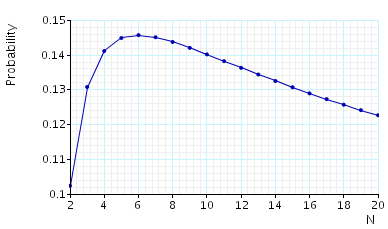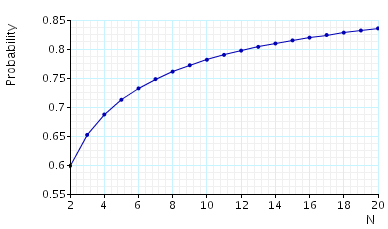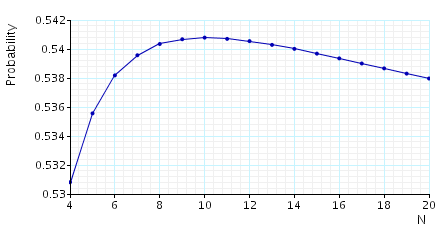(Ibe and Trivedi)
This case study is based on a cyclic server polling system, taken from [IT90]. The model is represented as a CTMC. We use N to denote the number of stations handled by the polling server. By way of example, the PRISM source code for the case where N=5 is given below.
// polling example [IT90] // gxn/dxp 26/01/00 ctmc const int N=5; const double mu= 1; const double gamma= 200; const double lambda= mu/N; module server s : [1..5]; // station a : [0..1]; // action: 0=polling, 1=serving [loop1a] (s=1)&(a=0) -> gamma : (s'=s+1); [loop1b] (s=1)&(a=0) -> gamma : (a'=1); [serve1] (s=1)&(a=1) -> mu : (s'=s+1)&(a'=0); [loop2a] (s=2)&(a=0) -> gamma : (s'=s+1); [loop2b] (s=2)&(a=0) -> gamma : (a'=1); [serve2] (s=2)&(a=1) -> mu : (s'=s+1)&(a'=0); [loop3a] (s=3)&(a=0) -> gamma : (s'=s+1); [loop3b] (s=3)&(a=0) -> gamma : (a'=1); [serve3] (s=3)&(a=1) -> mu : (s'=s+1)&(a'=0); [loop4a] (s=4)&(a=0) -> gamma : (s'=s+1); [loop4b] (s=4)&(a=0) -> gamma : (a'=1); [serve4] (s=4)&(a=1) -> mu : (s'=s+1)&(a'=0); [loop5a] (s=5)&(a=0) -> gamma : (s'=1); [loop5b] (s=5)&(a=0) -> gamma : (a'=1); [serve5] (s=5)&(a=1) -> mu : (s'=1)&(a'=0); endmodule module station1 s1 : [0..1]; [loop1a] (s1=0) -> 1 : (s1'=0); [] (s1=0) -> lambda : (s1'=1); [loop1b] (s1=1) -> 1 : (s1'=1); [serve1] (s1=1) -> 1 : (s1'=0); endmodule // construct further stations through renaming module station2 = station1 [s1=s2, loop1a=loop2a, loop1b=loop2b, serve1=serve2] endmodule module station3 = station1 [s1=s3, loop1a=loop3a, loop1b=loop3b, serve1=serve3] endmodule module station4 = station1 [s1=s4, loop1a=loop4a, loop1b=loop4b, serve1=serve4] endmodule module station5 = station1 [s1=s5, loop1a=loop5a, loop1b=loop5b, serve1=serve5] endmodule // cumulative rewards rewards "waiting" // expected time the station 1 is waiting to be served s1=1 & !(s=1 & a=1) : 1; endrewards rewards "served" // expected number of times station1 is served [serve1] true : 1; endrewards
The table below shows statistics for each model we have built. The first section gives information about the CTMC representing the model: the number of states and the number of non-zeros (transitions). The second part refers to the MTBDD which represents this CTMC: the total number of nodes, the number of leaves (terminal nodes), and the amount of memory needed to store it. The last column gives the amount of memory a sparse matrix would need to represent the same CTMC.
| N: | Model: | MTBDD: | Sparse: | ||||||
| States: | NNZ: | Nodes: | Leaves: | Kb: | Kb: | ||||
| 4 | 96 | 272 | 178 | 4 | 3.48 | 4.3 | |||
| 5 | 240 | 800 | 271 | 4 | 5.29 | 12.2 | |||
| 6 | 576 | 2,208 | 367 | 4 | 7.17 | 32.6 | |||
| 7 | 1,344 | 5,824 | 482 | 4 | 14.9 | 84 | |||
| 8 | 3,072 | 14,848 | 608 | 4 | 11.9 | 210 | |||
| 9 | 6,912 | 36,864 | 765 | 4 | 14.9 | 513 | |||
| 10 | 15,360 | 89,600 | 921 | 4 | 18.0 | 1,230 | |||
| 11 | 33,792 | 214,016 | 1,096 | 4 | 21.4 | 2,904 | |||
| 12 | 73,728 | 503,808 | 1,282 | 4 | 25.0 | 6,768 | |||
| 13 | 159,744 | 1,171,456 | 1,491 | 4 | 33.3 | 15,600 | |||
| 14 | 344,064 | 2,695,168 | 1,707 | 4 | 33.3 | 35,616 | |||
| 15 | 737,280 | 6,144,000 | 1,942 | 4 | 37.9 | 80,640 | |||
| 16 | 1,572,864 | 13,893,632 | 2,188 | 4 | 42.7 | 371,712 | |||
| 17 | 3,342,336 | 31,195,136 | 2,469 | 4 | 48.2 | 378,624 | |||
| 18 | 7,077,888 | 69,599,232 | 2,745 | 4 | 53.6 | 843,264 | |||
| 19 | 14,942,208 | 154,402,816 | 3,040 | 4 | 59.4 | 1,867,776 | |||
| 20 | 31,457,280 | 340,787,200 | 3,346 | 4 | 65.4 | 4,116,362 | |||
The table below gives the times taken to construct the models. This process involves first building a CTMC (represented as an MTBDD) from the system description (in our module based language), and then computing the reachable states using a BDD based fixpoint algorithm. The total time required and the number of fixpoint iterations are given below.
| N: | Construction: | ||
| Time (s): | Iter.s: | ||
| 4 | 0.039 | 9 | |
| 5 | 0.043 | 11 | |
| 6 | 0.059 | 13 | |
| 7 | 0.063 | 15 | |
| 8 | 0.069 | 17 | |
| 9 | 0.09 | 19 | |
| 10 | 0.107 | 21 | |
| 11 | 0.115 | 23 | |
| 12 | 0.126 | 25 | |
| 13 | 0.144 | 27 | |
| 14 | 0.156 | 29 | |
| 15 | 0.19 | 31 | |
| 16 | 0.202 | 33 | |
| 17 | 0.239 | 35 | |
| 18 | 0.271 | 37 | |
| 19 | 0.302 | 39 | |
| 20 | 0.346 | 41 | |
We now report on the model checking results obtained using PRISM when checking the following CSL specifications.
// Time bound const double T; // Probability that in the long run station 1 is awaiting service S=? [ s1=1 & !(s=1 & a=1) ] // Probability that in the long run station 1 is idle S=? [ s1=0 ] // Once a station becomes full, the minimum probability it will eventually be polled P=? [ true U (s=1 & a=0) {s1=1}{min} ] // Probability, from the inital state, that station 1 is served before station 2 P=? [ !(s=2 & a=1) U (s=1 & a=1) ] // Probability that station 1 will be polled within T time units P=?[ true U<=T (s=1 & a=0) ] // Expected time that station 1 is waiting to be served R{"waiting"}=?[C<=T] // Expected number of times station1 is served R{"served"}=?[C<=T] // number of times station1 is served
All experiments were carried out on a 2.80GHz PC with 1 Gb memory running Linux and in all iterative methods we stop iterating when the relative error between subsequent iteration vectors is less than 1e-6, that is:

Computing Steady State Probabilities: the table below gives the model checking statistics when computing these probabilities for both the Jacobi and Gauss-Seidel methods when using PRISM's different engines.
| N: | Jacobi: | Gauss Seidel: | ||||||||
| Iters: | Time per iter: (s) | Iters: | Time per iter: (s) | |||||||
| MTBDD | Sparse | Hybrid | Sparse | Hybrid | ||||||
| 4 | 130 | 0.001100 | < 0.00001 | 0.000015 | 18 | < 0.00001 | < 0.00001 | |||
| 5 | 173 | 0.002931 | 0.000012 | 0.000012 | 20 | < 0.00001 | < 0.00001 | |||
| 6 | 218 | 0.007445 | 0.000014 | 0.000028 | 22 | < 0.00001 | < 0.00001 | |||
| 7 | 264 | 0.020572 | 0.000042 | 0.000068 | 23 | 0.000087 | 0.000087 | |||
| 8 | 310 | 0.059178 | 0.000100 | 0.000158 | 25 | 0.000160 | 0.000320 | |||
| 9 | 358 | 0.256704 | 0.000257 | 0.000377 | 26 | 0.000462 | 0.000692 | |||
| 10 | 406 | - | 0.000643 | 0.000958 | 27 | 0.001037 | 0.001667 | |||
| 11 | 455 | - | 0.001545 | 0.002455 | 28 | 0.002393 | 0.003893 | |||
| 12 | 505 | - | 0.003612 | 0.006646 | 29 | 0.005207 | 0.009069 | |||
| 13 | 555 | - | 0.008295 | 0.015944 | 30 | 0.011733 | 0.020300 | |||
| 14 | 606 | - | 0.019363 | 0.035465 | 31 | 0.026161 | 0.045065 | |||
| 15 | 657 | - | 0.044633 | 0.080626 | 32 | 0.058656 | 0.104188 | |||
| 16 | 709 | - | 0.106413 | 0.191898 | 33 | 0.130212 | 0.231152 | |||
| 17 | 761 | - | 0.235858 | 0.409599 | 34 | 0.288147 | 0.537794 | |||
| 18 | 814 | - | 0.567683 | 0.908693 | 34 | 0.643882 | 1.187500 | |||
| 19 | 866 | - | 1.325487 | 2.003745 | 35 | 1.462714 | 2.633857 | |||
| 20 | 920 | - | - | 4.664724 | 36 | - | 5.759333 | |||
Probability that in the long run station 1 is awaiting service:

Probability that in the long run station 1 is idle:

Once station 1 becomes full, the minimum probability it will eventually be polled: the table below presents statistics for the model checking process. Note that as this property holds with probability 1 the statistics correspond to a BDD precomputation algorithm.
| N: | Iters: | Time per iter: (s) | Minimum probability: |
| 4 | 18 | <0.000001 | 1 |
| 5 | 22 | <0.000001 | 1 |
| 6 | 26 | 0.000385 | 1 |
| 7 | 30 | 0.000333 | 1 |
| 8 | 34 | 0.000294 | 1 |
| 9 | 38 | 0.000526 | 1 |
| 10 | 42 | 0.000714 | 1 |
| 11 | 46 | 0.000870 | 1 |
| 12 | 50 | 0.000800 | 1 |
| 13 | 54 | 0.001111 | 1 |
| 14 | 58 | 0.001207 | 1 |
| 15 | 62 | 0.001290 | 1 |
| 16 | 66 | 0.001515 | 1 |
| 17 | 70 | 0.001714 | 1 |
| 18 | 74 | 0.001757 | 1 |
| 19 | 78 | 0.002073 | 1 |
| 20 | 82 | 0.002308 | 1 |
The probability that, from the initial state, station 1 is polled before station 2: the table and below gives the model checking statistics when computing these probabilities for both the Jacobi and Gauss-Seidel methods when using PRISM's different engines.
| N: | Jacobi: | Gauss Seidel: | ||||||||
| Iters: | Time per iter: (s) | Iters: | Time per iter: (s) | |||||||
| MTBDD | Sparse | Hybrid | Sparse | Hybrid | ||||||
| 4 | 2,480 | 0.000463 | 0.000002 | 0.000002 | 1,862 | 0.000009 | 0.000011 | |||
| 5 | 2,664 | 0.000848 | 0.000005 | 0.000006 | 2,285 | 0.000021 | 0.000024 | |||
| 6 | 2,965 | 0.002041 | 0.000013 | 0.000016 | 2,479 | 0.000044 | 0.000045 | |||
| 7 | 3,124 | 0.005206 | 0.000030 | 0.000041 | 2,809 | 0.000095 | 0.000102 | |||
| 8 | 3,374 | 0.013286 | 0.000076 | 0.000101 | 2,965 | 0.000209 | 0.000233 | |||
| 9 | 3,516 | 0.033981 | 0.000180 | 0.000232 | 3,239 | 0.000455 | 0.000516 | |||
| 10 | 3,732 | 0.082460 | 0.000457 | 0.000560 | 3,374 | 0.000993 | 0.000956 | |||
| 11 | 3,863 | 0.193670 | 0.001076 | 0.001510 | 3,612 | 0.002220 | 0.002256 | |||
| 12 | 4,054 | 0.450005 | 0.002393 | 0.004357 | 3,734 | 0.004809 | 0.005239 | |||
| 13 | 4,176 | 1.047451 | 0.005484 | 0.009719 | 3,945 | 0.010381 | 0.009450 | |||
| 14 | 4,351 | - | 0.012999 | 0.022378 | 4,058 | 0.023012 | 0.021251 | |||
| 15 | 4,464 | - | 0.027970 | 0.049814 | 4,249 | 0.049110 | 0.047892 | |||
| 16 | 4,623 | - | 0.066075 | 0.111454 | 4,354 | 0.106876 | 0.106191 | |||
| 17 | 4,732 | - | 0.144911 | 0.247469 | 4,529 | 0.233834 | 0.243856 | |||
| 18 | 4,880 | - | 0.332425 | 0.554729 | 4,629 | 0.539982 | 0.535855 | |||
| 19 | 4,983 | - | 0.769429 | 1.226136 | 4,791 | 1.262000 | 1.185987 | |||
| 20 | 5,122 | - | - | 2.666418 | 4,886 | - | 2.657864 | |||
The graph below we have plotted these probabilities as the number of stations varies.

The minimum probability that once station 1 is full it is polled within T time units: the table below presents statistics for the model checking process.
| N: | T=5: | T=50: | |||||||||
| Iters: | Time per iter: (s) | Iters: | Time per iter: (s) | ||||||||
| MTBDD | Sparse | Hybrid | MTBDD | Sparse | Hybrid | ||||||
| 4 | 1,299 | 0.000108 | 0.000002 | 0.000004 | 3,029 | 0.000097 | 0.000002 | 0.000004 | |||
| 5 | 1,299 | 0.000360 | 0.000008 | 0.000012 | 3,390 | 0.000325 | 0.000006 | 0.000012 | |||
| 6 | 1,299 | 0.000833 | 0.000017 | 0.000033 | 3,735 | 0.000638 | 0.000016 | 0.000032 | |||
| 7 | 1,299 | 0.001525 | 0.000044 | 0.000089 | 4,068 | 0.001276 | 0.000040 | 0.000087 | |||
| 8 | 1,299 | 0.002905 | 0.000105 | 0.000226 | 4,393 | 0.002599 | 0.000100 | 0.000220 | |||
| 9 | 1,299 | 0.005907 | 0.000259 | 0.000557 | 4,709 | 0.005640 | 0.000245 | 0.000545 | |||
| 10 | 1,299 | 0.013120 | 0.000669 | 0.001400 | 5,019 | 0.012821 | 0.000612 | 0.001356 | |||
| 11 | 1,299 | 0.031202 | 0.001577 | 0.003540 | 5,324 | 0.030340 | 0.001483 | 0.003444 | |||
| 12 | 1,299 | 0.073051 | 0.003677 | 0.009074 | 5,625 | 0.069625 | 0.003399 | 0.008809 | |||
| 13 | 1,299 | 0.175253 | 0.008447 | 0.021134 | 5,921 | 0.151677 | 0.007790 | 0.020601 | |||
| 14 | 1,299 | 0.447443 | 0.019534 | 0.048891 | 6,213 | 0.350896 | 0.018084 | 0.049279 | |||
| 15 | 1,299 | 1.332977 | 0.045169 | 0.111782 | 6,503 | 0.882448 | 0.041978 | 0.109156 | |||
| 16 | 1,299 | 4.823504 | 0.109159 | 0.255657 | 6,789 | 2.453282 | 0.101669 | 0.249149 | |||
| 17 | 1,299 | - | 0.236249 | 0.574657 | 7,073 | - | 0.220543 | 0.559372 | |||
| 18 | 1,299 | - | 0.572048 | 1.288513 | 7,355 | - | 0.538752 | 1.253214 | |||
| 19 | 1,299 | - | 1.376863 | 2.853521 | 7,634 | - | 1.248819 | 2.778883 | |||
| 20 | 1,299 | - | - | 6.311027 | 7,911 | - | - | 6.146424 | |||
In the graph below, we plot results of the above property for different numbers of stations (values of N):

Expected time station 1 spends awaiting service by time T: the table and graph below we present the model checking statistics as both the number of stations and time bound T varies.
| N: | T=5: | T=50: | |||||||||
| Iters: | Time per iter: (s) | Iters: | Time per iter: (s) | ||||||||
| MTBDD | Sparse | Hybrid | MTBDD | Sparse | Hybrid | ||||||
| 4 | 1,299 | 0.000270 | 0.000003 | 0.000006 | 3,856 | 0.000266 | 0.000004 | 0.000006 | |||
| 5 | 1,299 | 0.000653 | 0.000008 | 0.000017 | 4,766 | 0.000656 | 0.000009 | 0.000017 | |||
| 6 | 1,299 | 0.001532 | 0.000022 | 0.000040 | 5,677 | 0.001534 | 0.000025 | 0.000044 | |||
| 7 | 1,299 | 0.003857 | 0.000059 | 0.000107 | 6,585 | 0.003828 | 0.000063 | 0.000112 | |||
| 8 | 1,299 | 0.010498 | 0.000142 | 0.000266 | 7,489 | 0.010605 | 0.000150 | 0.000276 | |||
| 9 | 1,299 | 0.027769 | 0.000342 | 0.000649 | 8,391 | 0.028500 | 0.000361 | 0.000676 | |||
| 10 | 1,299 | 0.070794 | 0.000841 | 0.001601 | 9,290 | 0.075488 | 0.000865 | 0.001653 | |||
| 11 | 1,299 | 0.175307 | 0.001948 | 0.004038 | 10,187 | 0.207029 | 0.002015 | 0.004120 | |||
| 12 | 1,299 | 0.473611 | 0.004470 | 0.010046 | 11,082 | 0.951248 | 0.009620 | 0.010143 | |||
| 13 | 1,299 | 1.264613 | 0.010242 | 0.023289 | 11,111 | 3.642436 | 0.010285 | 0.023461 | |||
| 14 | 1,299 | - | 0.023290 | 0.053094 | 11,111 | - | 0.023422 | 0.053808 | |||
| 15 | 1,299 | - | 0.052793 | 0.120839 | 11,112 | - | 0.053346 | 0.121939 | |||
| 16 | 1,299 | - | 0.124015 | 0.273636 | 11,112 | - | 0.126152 | 0.276256 | |||
| 17 | 1,299 | - | 0.269986 | 0.611949 | 11,112 | - | 0.274005 | 0.616791 | |||
| 18 | 1,299 | - | 0.639747 | 1.400105 | 11,112 | - | 0.650463 | 1.371019 | |||
| 19 | 1,299 | - | - | 3.016768 | 11,112 | - | - | 3.030094 | |||
| 20 | 1,299 | - | - | 6.629515 | 11,112 | - | - | 6.676664 | |||

Expected number of times station 1 is served by time T:
